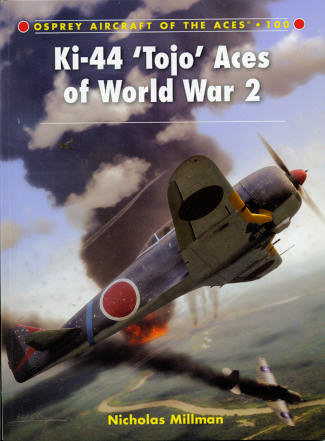 Developed
prior to the Pacific War, the Ki-44 was a real departure in fighters for the
IJAAF. It was their first interceptor. Build for speed and the ability to reach
altitude in the shortest time possible, the 'Shoki' had the highest wing loading
of any Japanese military aircraft built to date. Originally intended only for
class A pilots with over 1,000 hours in the air, it was eventually flown by
lower qualified pilots without any major problems.
Developed
prior to the Pacific War, the Ki-44 was a real departure in fighters for the
IJAAF. It was their first interceptor. Build for speed and the ability to reach
altitude in the shortest time possible, the 'Shoki' had the highest wing loading
of any Japanese military aircraft built to date. Originally intended only for
class A pilots with over 1,000 hours in the air, it was eventually flown by
lower qualified pilots without any major problems.
Of course, it had many detractors when it first entered
service. It was not maneuverable, but it had plenty of power and could dive with
the best Allied fighter. Probably one of the first Japanese aircraft that fought
well in the vertical, something that is now common with fighters. Those that
realized that 'hit and run' tactics were the best for this plane did well. Those
that stuck with dog fighting found out that they were at a major disadvantage.
The aircraft had several innovations. For one it carried wing
armament in the form of 12.7mm guns when the normal armament was just two 7.7mm
guns in the nose. It also had fowler type flaps for improved take-off and
landing characteristics. These could also be used as 'combat flaps' to help
improve the aircraft's turning. Unusual in fighters, the flap controls were two
buttons on the top of the control stick while the gun trigger was attached to
the throttle control. Later versions had 40mm wing guns with unique ammunition
that had no ejectable shell casing. Perforations in the back of the shell added
additional force to the shell and obviated the need for a separate case.
The first combat missions for the Ki-44 were in early January
1942 when pre-production aircraft were sent to the Burma theater where they
fought the British and the AVG. Yet it was not until mid 1943, after the type
had been in unit service for over a year that it was identified by Allies as
being a new type. Most of the operational use of the Ki-44 was in China,
Manchuria, and over the home islands where it was one of the few planes that
could reach B-29s. However, its performance at that altitude was lacking and the
high wing loading made maneuvering tricky. The Ki-44 was used quite a bit in
ramming attacks and its 40mm cannon were devastating if it hit the bomber.
Author Nicholas Millman has scoured archives to come up with
information on the operational use of the Ki-44 and thanks to his work and that
of others, we now have a clear picture of the use of the 'Tojo' by IJAAF forces
and the men who flew them. Those who took advantage of the aircraft's strengths
were quite successful, including several B-29 aces and some who used the Ki-44
to amass a rather large victory score.
In addition to the history of the plane and the stories of
the pilots who flew it, there are a number of excellent period photos of the men
and planes. This includes the usual full color profiles that we have come to
expect from Osprey. Unlike other IJAAF aircraft of the Pacific war, not one
example of the Ki-44 exists today.
Overall, it is a superb read and an excellent reference. You
really cannot go wrong with this or any other book in the series.
October 2011
For more on the complete line of Osprey books,
visit www.ospreypublishing.com. In the US, it is
Osprey Direct at 44-02 23rd St, Suite 219, Long Island City, NY 11101., where you can
get a catalogue of available books.
If you would like your product reviewed fairly and quickly, please contact
me or see other details in the Note to
Contributors.
 Developed
prior to the Pacific War, the Ki-44 was a real departure in fighters for the
IJAAF. It was their first interceptor. Build for speed and the ability to reach
altitude in the shortest time possible, the 'Shoki' had the highest wing loading
of any Japanese military aircraft built to date. Originally intended only for
class A pilots with over 1,000 hours in the air, it was eventually flown by
lower qualified pilots without any major problems.
Developed
prior to the Pacific War, the Ki-44 was a real departure in fighters for the
IJAAF. It was their first interceptor. Build for speed and the ability to reach
altitude in the shortest time possible, the 'Shoki' had the highest wing loading
of any Japanese military aircraft built to date. Originally intended only for
class A pilots with over 1,000 hours in the air, it was eventually flown by
lower qualified pilots without any major problems.